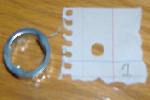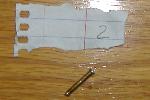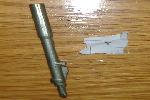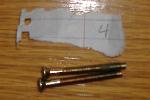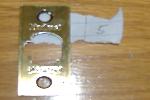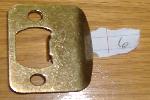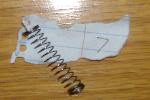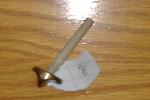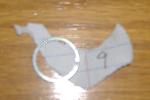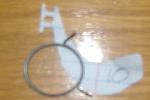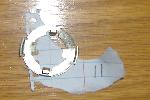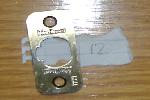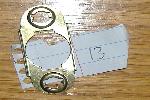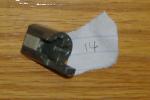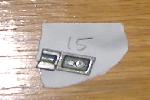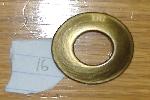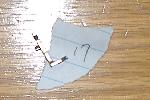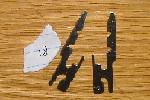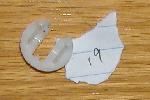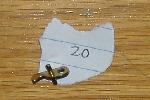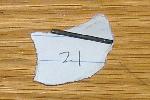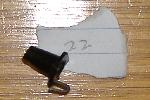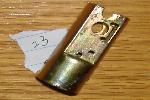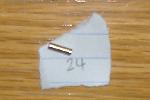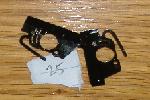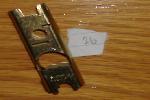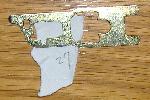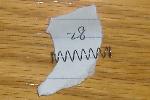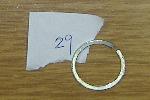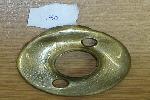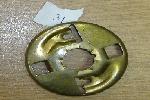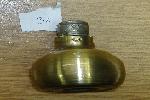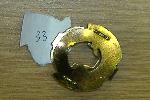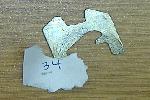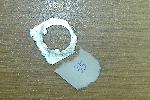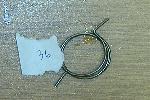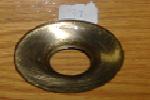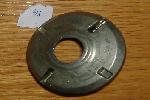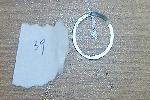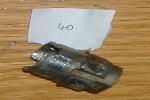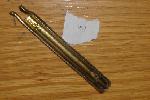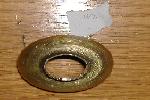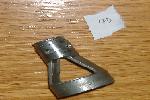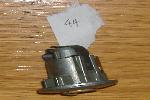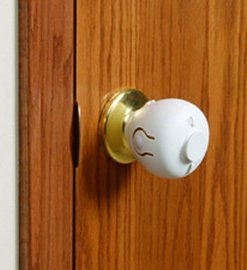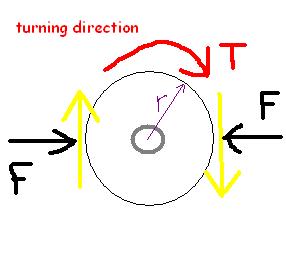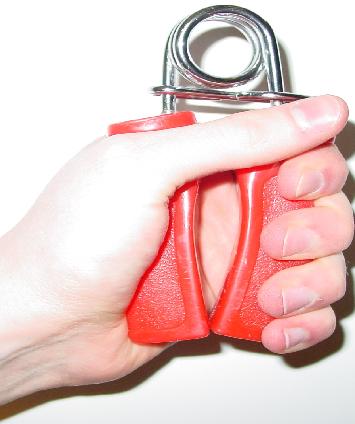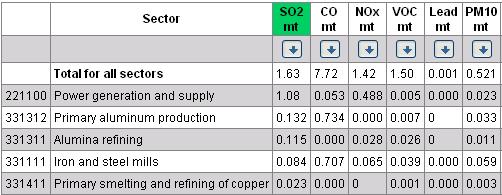Babyproof door knob lock
From DDL Wiki
(→FMEA) |
(→FMEA) |
||
| Line 240: | Line 240: | ||
|| | || | ||
"Deter curious children from entering rooms or closets that might contain a danger" | "Deter curious children from entering rooms or closets that might contain a danger" | ||
| - | + | Steps: <br /> | |
| - | + | 1. Walk to a door <br /> | |
| - | + | 2. Lift hand <br /> | |
| - | + | 3. Grasp door knob cover with thumb and fore finger on tabs | |
| - | + | 4. Squeeze tabs until they rest firmly against the door knob<br /> | |
| - | + | 5. Twist the knob away from door jam <br /> | |
| - | + | 6. Push or pull the door open/close | |
| - | + | ||
| - | + | ||
| - | + | ||
| - | + | ||
| - | + | ||
| - | + | ||
| - | + | ||
| - | + | ||
| - | + | ||
| - | + | ||
| - | + | ||
| - | + | ||
| - | + | ||
| - | + | ||
| - | + | ||
| - | + | ||
| - | + | ||
| - | + | ||
| - | + | ||
| - | + | ||
| - | + | ||
| - | + | ||
| - | + | ||
| - | + | ||
| - | + | ||
| - | + | ||
| - | + | ||
| - | + | ||
| - | + | ||
| - | + | ||
| - | + | ||
| - | + | ||
| - | + | ||
| - | + | ||
| - | + | ||
| - | + | ||
| - | + | ||
| - | + | ||
| - | + | ||
| - | + | ||
| - | + | ||
| - | + | ||
| - | + | ||
| - | + | ||
| - | + | ||
| - | + | ||
| - | + | ||
| - | + | ||
| - | + | ||
| - | + | ||
| - | + | ||
| - | + | ||
| - | + | ||
| - | + | ||
| - | + | ||
| - | + | ||
| - | + | ||
| - | + | ||
| - | + | ||
| - | + | ||
| - | + | ||
| - | + | ||
| - | + | ||
| - | + | ||
| - | + | ||
| - | + | ||
| - | + | ||
| - | + | ||
| - | + | ||
| - | + | ||
| - | + | ||
| - | + | ||
| - | + | ||
| - | + | ||
| - | + | ||
| - | + | ||
| - | + | ||
| - | + | ||
| - | + | ||
| - | + | ||
| - | + | ||
| - | + | ||
| - | + | ||
| - | + | ||
| - | + | ||
| - | + | ||
| - | + | ||
| - | + | ||
| - | + | ||
| - | + | ||
| - | + | ||
| - | + | ||
|} | |} | ||
Revision as of 04:07, 24 September 2007
Contents |
Executive Summary
Babyproof door knob locks are a common method in many households to restrain children within a certain area. This information page analyzes both the babyproof lock in addition to type of door knob to which it is attached. By fully understanding the consumer needs in addition to the exact function and manufacturing methods of the system under study our team hopes to innovate and improve upon products already available for purchase. By not only analyzing the babyproofing cover but also studying the complex mechanism of the doorknob itself, this study is provided extra depth.
A doorknob's primary purpose is to allow selective entry and exit between connected rooms. This simple of objective has evolved a complex mechanism with many points for possible failure. Locking and unlocking, the doorknob-to-door interface, and even the impact of rotation must be accommodated by the doorknob within a reasonable failure tolerance. Via product dissection, a deeper understanding of each item of the assembly is gained. FMEA allowed possible failure areas to be outlined and ranked while DFMA structured possible improvements in a systematic fashion.
A babyproof door knob lock's initial simplicity is complicated by its defined interaction with the doorknob mentioned previously. Deconstruction and analysis must always take into consideration what effect each component has upon a doorknob. Varying standards in size, quality and complexity of doorknobs themselves complicate the manufacture of the door knob locks. By combining the information from both of these products, a comprehensive improvement plan can be produced that minimizes parts and cost while maximizing effectiveness.
Customer Needs
A customer with a toddler needs to safeguard their home while the child is in a stage where they want to explore their surroundings and abilities but are unaware of hidden dangers. To deter a child from opening or closing a door but still make it as accessible to normal adult traffic as possible, a special mechanism is needed, potentially on the doorknob. Customers need to also take into consideration the type of door knob (knob, lever, etc.), it's size, shape, and whether or not the knob has a lock that they also want to easily access in other situations.
Product Use
An uncovered, unlocked doorknob is simply turned to open or close a door. To deter a small child from doing so, there are two different types of covers we're exploring. The first is specifically for round doorknobs. It covers the knob loosely so that it spins freely unless tabs are pressed on its side that creates friction between the cover and knob, causing the knob to turn when the cover is turned. The second is for levers. There is a lever cover and a "lock". This lock is a latch that is attached to the door above the knob with a tab that fits into a notch in the cover. The tab prevents the cover from moving unless the tab is lifted.
Product Dissection
| # | Name | Weight | Material | Manufacturing Technique | Function | photo |
|---|---|---|---|---|---|---|
| 45 | shell#1 | -- | plastic | molded | covers half of the doorknob | 
|
| 46 | shell#2 | -- | plastic | molded | covers half of the doorknob | 
|
| 47 | contact pad | -- | rubber | chemically synthesized/injected to plastic | creates friction between doorknob and shell | Image:Doorknob protector03.jpg |
DFMA
In this section we will address the door knob and its baby proof cover's design for manufacture and assembly.
Design For Manufacture
Door Knob:
• Parts such as the latch plate and strike plate that are single flat pieces that are stamped and cut most likely come from a single sheet of metal, minimizing waste
• Springs usually come pre-manufactured as one large coil that can be cut to the length desired. The screws, bolts, rivets, and pins also most likely were pre-manufactured by an external provider.
• The doorknob does contain a number of individually molded parts such as the latch, turning shaft, and roses.
Door Knob Cover:
• The frame of the cover is injected molded in two halves.
•
Design for Assembly
Door Knob:
• The latch assembly was not well designed for assembly. There are several parts that must be put into place deep inside of the latch housing, but since the housing is a tube-like structure, that appears very difficult. The pieces inside the latch assembly do not appear to fit firmly together outside of the housing, so it is doubtful that the mechanism was placed together and then placed wholly into the housing.
• Inner and outer doorknob are simpler, having smaller assemblies placed into larger assemblies such as the torsional spring placed into the two halves of the spring housing which in turn was placed into the rose. Many of these pars are press fitted to each other.
• The whole door knob assembly is sold to the consumer in three main parts not including the latch plate and strike plate. This is because of the standard way the door knobs and latch assembly are placed into the door relevant to each other. The latch assembly slides into a hole in the side of the door that faces the door frame with the latch protruding from the hole. The outer and inner doorknobs are then placed on the outer and inner side of the door relatively. To connect to each other and make the latch function, the inner and outer doorknobs must reach through the latch assembly.
Door Knob Cover:
• The Door knob cover only requires assembly by the user.
FMEA
| Item and Function | Failure Mode | Effects of Failure | S | Causes of Failure | O | Design Controls | D | RPN | Recommended Actions | |
|---|---|---|---|---|---|---|---|---|---|---|
| Door Knob Cover Tabs • Is squeezed by user to create friction between the tabs and the door knob. | User is not able to squeeze tabs and generate enough friction to turn the knob | User cannot open door | 10 | Contact area of tabs is too small | 5 | Test the amount of force needed to squeeze tabs and turn knob | 3 | 150 | based on test, increase area of tab or change lock function | |
| Door Knob Cover Latches • Connects too halves of cover together | Latches break | Two halves are not able to connect to each other properly | 7 | Material fatige | 2 | Test maximum force latches can endure | 1 | 14 | based on test, redesign tabs | |
| Door Knob Cover Material • Is injected molded PC plastic | Plastic may not be fire resistant | Impedes exit in case of fire | 10 | Material failure due to heat | 5 | Test peak temperature resistance | 1 | 50 | based on test, choose material or coating | |
| Shape of Door Knob Cover • Cover is round and shaped based on average diameter of door knob | Despite size of cover being based on an average, door knob sizes can vary widely creating an ill fit. Also, is not designed for levers | Cover may not be usable on that particular door knob | 8 | Design limitation | 5 | Test different sized door knobs | 1 | 50 | based on test, consider design changes and compatibility with levers | |
| Door knob latch • Secures door against door jam in closed positon, retracts when knob is turned to allow door to open | Latch assembly rusts or fills with debris | Latch fails to retract | 9 | Exposure to environment | 3 | Lubricate assembly | 1 | 27 | n/a |
| Material/Analysis | Doorknob | Doorknob Protector |
|---|---|---|
| Who Are the Stake Holders? |
Homeowners and families |
Moms, dads, guardians, children, anyone in the house |
| What it Does and How it is Used |
Secures a door |
"Deter curious children from entering rooms or closets that might contain a danger"
Steps: |
Quantitative Mechanical Analysis
Friction plays an important role when turning a doorknob covered with a protector. The protector allows free spinning when force is not applied. This is results in selective door entrance/exit as young children are unable to grip the knob.
F1 = minimum force required to turn doorknob with cover F2 = minimum force required to turn doorknob without cover
F1 - F2 = additional force required to open door when cover is used
A hand grip exercise instrument is used to measure the minimum amount of force required to turn a covered doorknob. By squeezing the doorknob until it turns, we will apply the same amount of force on the gripper. A displacement between the grip handles, or x, will be measured to estimate the amount of force applied. Given the spring constant, k, we can find F.
F = kx, where x is the total displacement between the grip handles.
DFE
The analysis for this section is broken down into DFE for the doorknob and DFE for the doorknob protector. The first analysis consists of just the doorknob. The following tables show the data obtained using the 1997 purchaser price model in the EIOLCA for $1 million worth of “Metal household furniture manufacturing”
Figure 1 EIOLCA data for toxic gas emissions
Figure 2 EIOLCA data for greenhouse gas emissions
Figure 3 EIOLCA data for conventional air pollution
Figure 4 EIOLCA data for energy consumption
The accuracy of these approximations is fairly rough as doorknobs do not necessarily take part in all sectors that contribute to certain emissions, ie paper mills & copper smelting. However, this data gives a rough idea of sectors that have the largest effect on environmental areas.
The following DFE is for the doorknob protector. The following tables show the data obtained using the 1997 purchaser price model in the EIOLCA for $1 million worth of “Plastic material and resin manufacturing”
Figure 5 EIOLCA data for toxic gas emissions
Figure 6 EIOLCA data for greenhouse gas emissions
Figure 7 EIOLCA data for conventional air pollution
Figure 8 EIOLCA data for energy consumption
These approximations are likely more accurate as the babyproof doorknob covers are made of plastics and likely undergo processes extremely similar to those in the industry area selected. Comparison of the two industries shows that green house and toxic gas emissions are the largest factors during manufacture. If the doorknob cover can be incorporated into the doorknob itself, it will cut down on emissions resulting from manufacture. The use of metal alloys instead of possibly non biodegradable plastics will also eliminate pollution upon end of life.
24-441 Engineering Design Course, Fall 2007, Carnegie Mellon University
